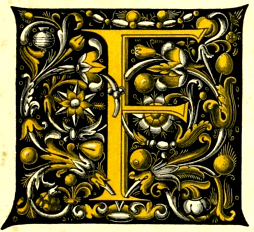
Gospels of Mac Durnan and commentary from The Art of Illumination and Missal Painting. Henry Noel Humphreys (1810-79), editor and illuminator. 17 x 15.5 cm. Collection: Center for British Art, Yale University This item was catalogue no. 52 in Beckwith, Victorian Bibliomania (1987) [Click on image to enlarge it.]
Commentary by Alice H. R. H. Beckwith

rom cover to conclusion in The Art of Illumination and Missal Painting Henry Noel Humphreys built a case for the advantages of practicing illumination and for acceptance of it among the liberal arts. As in his other works, the person of the illuminator interested Humphreys; here he went on to list the attributes of the modern illuminator. This paragon was a scientist, an iconographer, a literary scholar, and a historian of the decorative arts familiar with the history and practice of architecture, sculpture, and painting. Humphreys's description is autobiographical and raises the status of the illuminator beyond the reach of any but the most erudite. Yet education plays a democratizing role here, for it allows Humphreys to take advantage of the emerging tendency in the nineteenth century to define personal worth in terms of education and profession, instead of social standing (Clark, chapter 8).
Yale's copy of Humphreys's Art of Illumination and Missal Painting is one of a kind. As G. F. Ellis noted on the front free end paper, this volume belonged to Humphreys and contained his twelve watercolor models painted for the chromolithographed press edition. The original chromolithographed paper onlays from the publisher's binding are preserved as doublures inside the present full olive morocco covers. Beyond the obvious fascination such a unique volume offers, Humphreys's diminutive manual is bursting with interesting information, both in itself and in what it represents.
This book was a prototype for a succession of illuminators' manuals that eventually included works by Sir Matthew Digby Wyatt, Henry Shaw, and John Ruskin's assistant J. J. Laing (cats. 14, 38—40, 49). Humphreys's book and these others illustrate the interdependence between machines and handicraft, since the lithographic press aided the revival of the art of manual illumination. The Yale copy carries the interrelationship even further, for it shows that the machine process depended on hand work for models. Both Humphreys and Owen Jones saw the new age of machinery in a positive light and felt no qualms in rendering "mechanisms an auxiliary of art," in order to "point the way to higher efforts" (Humphreys, Illuminated Calendar, i). The format Humphreys established in his manual consisted of a short history of manuscript illumination followed by information for modern illuminators and a series of chromolithographed illustrations on which he commented.
Humphreys's approach to his manual and his success give insight into the demands of the mass market in the nineteenth century. Besides considering cost and visual appeal, he promised technical and theoretical information to his readers. Small size and a limited number of multi-color plates reduced the cost. However, the color plates were superb examples of chromolithography in as many as fourteen colors. For example, the white cover was blocked in a ribbon, leaf and spray pattern of gold and black over blue paper onlays, around a central chromolithographed panel of white lilies set against purple, blue, orange, green, and red backgrounds. The names of famous illuminators of the past including the Renaissance artist Giulio Clovio ornament six ribbons on the outer border of the cover.
The Art of Illumination and Missal Painting is a synthesis of Humphreys's work from the l840s. Between 1840 and 1846 he concerned himself with antiquarian facsimiles, and facsimiles are employed in Humphreys's manual. However, in 1847 with The Parables of Our Lord (cat. 7), he created the first of his own illuminated printed books. Certainly medieval works inspired Humphreys's later books, but as he said in The Art of Illumination, he no longer recommended or practiced direct imitation for the overall design of a book after 1847.
In this volume, page 7 and the facsimile of the Hiberno-Saxon Gospels of Moelbrigid Mac Durnan from the Lambeth Palace Library represent five different moments in the history of books and printing on two pages. On page 7, he created a collage of historical sources with wood engravings derived from fourteenth-century vines, a fifteenth-century initial letter D, and a sixteenth-century tailpiece, all surrounding Charles Whittingham's revived eighteenth-century old style Caslon type. In its vitality and broad use of historical precedent Humphreys's page has much in common with Victorian architects' approach to historical styles.
References
Beckwith, Alice H. R. H. Victorian Bibliomania: The Illuminated Book in Nineteenth-Century Britain. Exhibition catalogue. Providence. Rhode Island: Museum of Art, Rhode Island School of Design, 1987.
Humphreys, Henry Noel. The Art of Illumination and Missal Painting. A Guide to Modern Illuminators Illustrated by a Series of Specimens, from Richly Illuminated MSS. of Various Periods, Accompanied by a Set of Outlines, To Be Coloured by the Student According to Theories Developed in the Work. London: H. G. Bohn, 1849. Letterpress: Charles Whittingham, Chiswick Press.
Last modified 27 December 2013